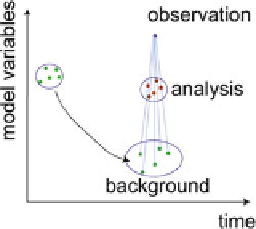Biomedical Engineering Reference
In-Depth Information
Fig. 1
Schematic illustration
of the data assimilation
procedure
here is the growth and spread of glioblastoma multiforme (GBM), a very aggressive
form of glioma brain tumor which remains extremely difficult to manage clinically.
The method employed is different from other approaches used in biology in that it
is independent of the mathematical model and seeks an optimal initial condition.
This is in contrast to other techniques such as those discussed in [
21
], which are
model dependent and seek to find an optimal model parameterization given the
observations and uncertainties in the system of interest.
The method discussed and implemented in this chapter is derived from numerical
weather prediction in which initial conditions to atmospheric weather models
must be updated frequently from noisy measurements. Chaos exhibited in the
underlying weather models leads to the propagation of uncertainty in the initial
conditions over short time periods. Thus accurate forecasting requires update of
forecast model initial conditions frequently (typically 6 h in global models) based
on current observational data. The algorithm for computing the update is known as
data assimilation
. Figure
1
summarizes the main elements of this procedure. One
begins with a model trajectory that represents the best estimate of the true state
of the system. This is advanced under the model, until a new observation becomes
available, producing the
background
. An update called the
analysis
is computed and
the process repeats. Under assumptions regarding the probability distribution of the
background and observation error, the analysis is a maximum-likelihood estimate of
the true system state.
In this chapter we demonstrate how the data assimilation approach might be
adapted to help anticipate the progression of clinical patient cases of GBM. GBM
is chosen because the dynamics of tumor growth are dependent on the location and
density of the underlying tumor cell population; hence, its dynamics are described
by a spatiotemporal model. Also noisy observations in the form of magnetic
resonance (MR) images are available which should provide insight into the current
state of the tumor (meaning the cancer cell density at every point on the brain
geometry). The overall approach is independent of the model; hence, this method
may be used on a broad range of spatiotemporally complex biological systems.
There are two principal sources of uncertainty in estimating the future growth
of GBM. First unlike the motions of the atmosphere, which can be described
by well-established physical models, many details of the growth of glioblastomas

Search WWH ::

Custom Search